Haryana Board Class 10 Physics Solutions For Chapter 3 Electricity Multiple Choice Questions And Answers
Question 1. A charge of 100 C flows through a bulb in 5 minutes. How much current is flowing through the bulb?
- 500 A
- 100 A
- 20 A
- 0.3 A
Answer: 3. 20 A
Question 2. A conducting wire carries 1021 electrons in 4 minutes. What is the current flowing through the wire?
- 40 A
- 7 A
- 4 A
- 0.7 A
Answer: 4. 0.7 A
Question 3. Work of 14 J is done to move 2 C charge between two points on a conducting wire. What is the potential difference between the two points?
- 28 V
- 14 V
- 7 V
- 3.5 V
Answer: 3. 7 V
Question 4. In order to move a charge of 3 C between two points on a conducting wire, 12 J of work is done. How much increase or decrease in the voltage will increase the work done on the same amount of charge to 36 J?
- -12 V
- -8 V
- +8 V
- +12 V
Answer: 3. +8 V
Question 5. A circuit has a charge of 2C moving through it in 3 s. Which electrical component in the circuit, if present, will show the current?
- Voltmeter will show a current of 6 A.
- Ammeter will show a current of 0.7 A.
- Rheostat will show a current of 0.7 A.
- Resistor will show a current of 0.35 A
Answer: 2. Ammeter will show a current of 0.7 A.
Question 6. The image shows a circuit diagram.
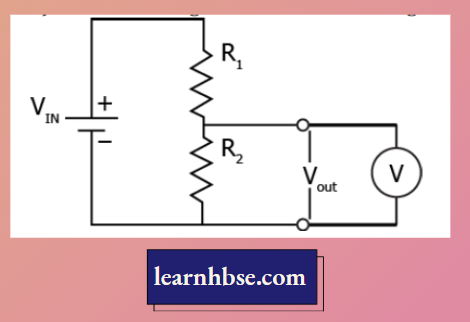
What is being measured using the voltmeter?
- Current in the circuit
- Voltage in the circuit
- Voltage across the resistor
- Resistance offered by the resistor
Answer: 3. Voltage across the resistor
Question 7. What is the relationship between resistance and current?
- They are directly related to each other.
- They are inversely related to each other.
- The resistance has a greater magnitude than current.
- The current has a greater magnitude than resistance.
Answer: 2. They are inversely related to each other.
Question 8. Which plot shows the change in voltage when the current is gradually decreased across a resistor?
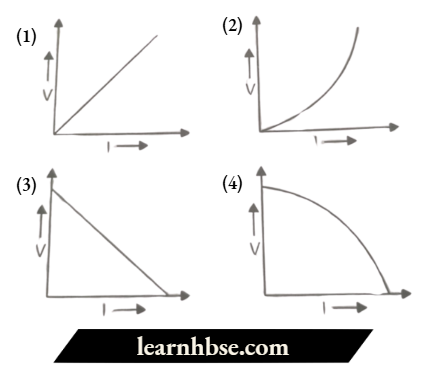
Answer: 1.
Question 9. Which one among a bar of an alloy of mass 2 kg and a 3 kg iron bar of same dimension has greater resistivity?
- An iron bar because it has a higher mass,
- Alloy bar because it has lower mass.
- Iron bar because it has the same types of atoms,
- Alloy bar because it has different types of atoms.
Answer: 4. Alloy bar because it has different types of atoms.
Question 10. A piece of wire is measured to have resistivity in the order of 1019 Ω m. What should its material be classified into?
- Alloys
- Insulators
- Good conductors
- Poor conductors
Answer: 2. Insulators
Question 11. Which combination of a 2 Ω resistor and 4 Ω resistor offers the least resistance to current in the circuit?
- Series combination, which results in a net resistance of 2Ω.
- Parallel combination, which results in a net resistance of 2Ω.
- Series combination, which results in a net resistance of 1.5Ω.
- Parallel combination, which results in a net resistance of 0.5Ω.
Answer: 4. Parallel combination, which results in a net resistance of 0.5.
Question 12. The image shows a combination of 4 resistors
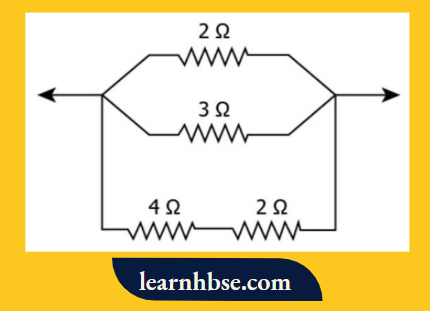
What is the net resistance between the two points in the circuit?
- 0.5 Ω
- 1.0 Ω
- 1.5 Ω
- 2.0 Ω
Answer: 2. 1.0 Ω
Question 13. How much more heat is produced if the urrent is doubled?
- Twice the original amount
- Thrice the original amount
- Four times the original amount.
- Five times the original amount.
Answer: 2. Thrice the original amount
Question 14. A bulb has a resistance of 5. If 2 A of current at 200 V flows through the bulb, how much heat is produced by the bulb in 10 minutes?
- 2.0 x 105 J
- 4.0 x 105 J
- 1.2 x 106 J
- 2.4 x 106 J
Answer: 4. 2.4 x 106 J
Question 15. In order to reduce electricity consumption at home, what kind of appliance should one purchase?
- One which draws low power
- One which produces less heat
- One which operates at a higher voltage
- One which draws a high amount of current
Answer: 1. One that draws low power
Question 16. An electric toaster has a power rating of 200 W. It operates for 1 hour in the morning and 1 hour in the evening. How much does it cost to operate the toaster for 10 days at Rs 5 per kW h?
- Rs 20
- Rs 400
- Rs 5000
- Rs 10000
Answer: 1. Rs 20
Chapter 3 Electricity Very Short Answer Questions
Question 1. What is meant by saying that the electric potential at a point is 1 volt?
Answer: Electric potential at a point is 1 volt means 1 joule of work is done in moving lunit positive charge from infinity to that point.
Question 2. The potential difference across the wire having fixed resistance is tripled. By how much does the electric power increase?
Answer: P = V2/R = (3V)2/R; P = 9P
Question 3. What is the commercial unit of energy?
Answer: Kilowatt-hour
Question 4. What is the relation between the resistance (R) of the filament of a bulb, its power (P), and a constant Voltage (V) applied across it?
Answer: P = V2/R
Question 5. What is the general name of the substances having infinitely high electrical resistance?
Answer: Insulators
Question 6. How is an ammeter connected in a circuit to measure the current flowing through it?
Answer: An Ammeter is connected in series in an electric circuit.
Question 7. Calculate the current in the circuit if 40 C of charge is passed through a point in 10 seconds.
Answer: I = Q/t = 40/10 = 4A
Question 8. State whether a voltmeter has a high resistance or a low resistance. Give a reason for your answer.
Answer: Voltmeter has a high resistance so that it takes a negligible current from the circuit.
Question 9. If the current in a wire is flowing in the vertically downward direction and a magnetic field is applied from west to east, what is the direction of the force on the wire?
Answer: According to Fleming’s left-hand rule direction of the force will be in the South direction.
Question 10. State whether an electric heater will consume more electrical energy or less electrical energy per second when the length of its heating element is reduced.
Answer: The electric heater will consume more electrical energy when the length of its heating element is reduced because resistance is directly proportional to length (R = ρ/ I x A ). Hence, resistance will decrease. Power is inversely proportional to resistance (P = V2R ) . Hence, power will increase.
Question 11. Define one coulomb charge.
Answer: One coulomb of charge is that quantity of charge which exerts a force of 9 x 109 Newton on an equal charge is placed at a distance of 1 m from it.
Question 12. A car headlight bulb working on a 12 V car battery draws a current of 0.5 A. The resistance of the light bulb is:
- 0.5 Ω
- 6 Ω
- 12 Ω
- 24 Ω
Answer: 3. 12
Question 13. If 20 C of charge passes a point in a circuit in 1 s, what current is flowing?
Answer: Q = 20 C, t = Is; I = Q/t; Thus, I = 20/1 = 20 A
Question 14. What is an electric current?
Answer: An electric current is a flow of electric charges (electrons) through a conductor.
Question 15. Which effect of current is utilized in an electric light bulb?
Answer: The Heating effect of electric current.
Question 16. State the expression for electrical power in terms of potential difference and resistance.
Answer: Electrical power, P = V2/R
Question 17. Name a device that helps to measure the potential difference across a conductor.
Answer: Voltmeter
Question 18. If a charge of 420 C is flowing from the wire for 5 minutes. Find the value of current.
Answer: 1 = q/t; q = 420 C; t = 5 minutes = 5 x 60 = 300 s ; I = 420/300 = 1.4 A
Question 19. How does the resistance of a pure metal change if its temperature decreases?
Answer: On decreasing the temperature, the resistance decreases.
Question 20. How many milliamperes are there in 1 ampere?
Answer: 1A = 102mA
Question 21. Why should the resistance of an ammeter be very small?
Answer: The resistance of an ammeter should be very small so that it may not change the value of the current flowing in the circuit.
Question 22. An electron enters a magnetic field at right angles to it, as shown in the figure. What is the direction of force acting on the electron?
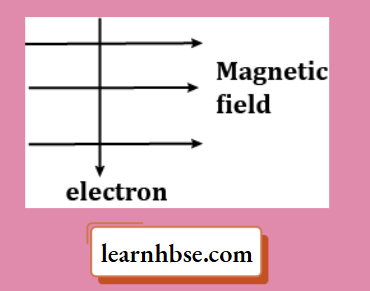
Answer: The direction of force is perpendicular to the direction of magnetic field and current as given by Fleming’s left hand rule. We know that the direction of current is taken opposite to the direction of motion of electrons. The force is therefore directed into the page.
Chapter 3 Electricity Short Questions And Answers
Question 1. Why it necessary to connect an earth wire to electric appliances having metallic bodies?
Answer:
An electric appliance with having metallic body can have current leak and current may flow through its body. It can be fatal if a person touches its current-carrying metallic body. So, it must be connected to an earth wire to pass the extra current, flowing through its body, to the earth plate.
Question 2. Two resistors each of 10 Ω are connected in
- Series
- And then in parallel to a battery of 6 V. Calculate the ratio of power consumed in the combination of resistor in two case.
Answer:
V = 6V; Total resistance in series, Rs = 20 Ω
Power, Ps = V2/R = 1.8 W; Total resistance in parallel, Rp = 5 Ω; Power, Pp = V2/R = 7.2 W
Ps/Pp = 1.8/7.2 = 4
Question 3. An electrical appliance is rated 240 V, 500 W. How much current will this appliance draw? It is planned to spend Rs 200 for running this appliance in a month. If the per unit cost is Rs 4.60, how many hours can this appliance be operated in a month of 30 days?
Answer:
Let the running time per day be “n” hours.
Running cost for 30 days = n x 0.5 x 4.60 x 30 = 200
Hence, n = 200/ (0.5 x 4.60 x 30) = 2 hours 54 minutes.
Question 4. Observe the given table, in which the values of current flowing through a conductor for corresponding values of potential difference across the conductor.
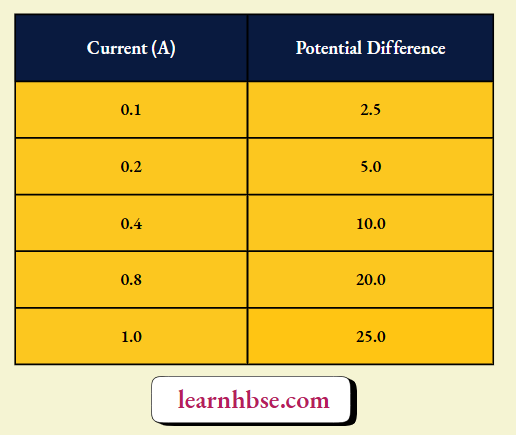
- Plot a graph between current and voltage.
- Calculate the resistance of the conductor.
Answer:
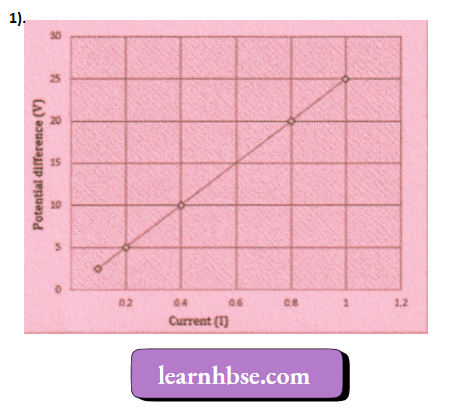
Resistance, R = V/l = 10/0.4 = 25 Ω
Question 5. Draw a schematic labelled diagram of a closed circuit which connects all the given components in series and is connected across a 12 V battery:
- 20 W lamp
- An ammeter
- A switch
- 10 Ω/100 W resistor
Answer:
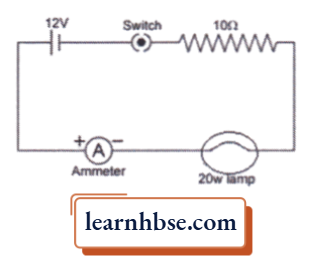
Question 6. The circuit diagram given below shows the combination of three resistors R1, R2 and R3:
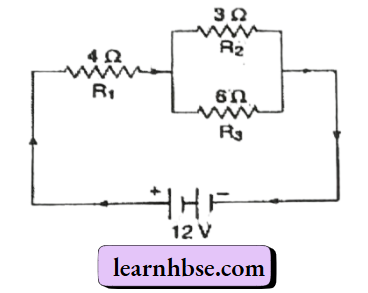
Find:
- Total resistance of the circuit.
- Total current flowing in the circuit.
Answer:
The total resistance of two resistors that are connected in parallel is
1/R’ = 1/3+1/6 1/R’ = 3/6 R’ = 2 Ω
Total resistance of the circuit = 2+4 = 6 Ω
Total current flowing through the circuit = V/total resistance
I = 12/6 = 2 A
Question 7. Study the circuit and find:
- Total resistance in arm CE
- Current in arm AB
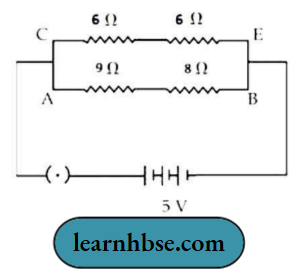
Answer:
Total resistance in arm CE Rs = 6 + 6 = 12 Ω
Current in arm AB, I = 5V/17 0 = 0.29A
Question 8. Observe the table given below and answer the questions:
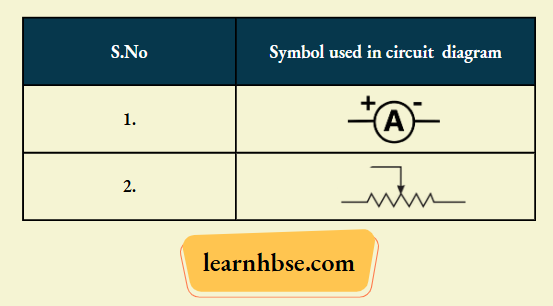
- What does the symbol (1) in the table given above represents?
- Which electrical component is represented when symbol (2) is used in circuit diagram?
Answer:
- Ammeter
- Rheostat
Question 9. Draw a circuit diagram to show how 3 bulbs can be lit from a battery so that 2 bulbs are controlled by the same switch while the third bulb has its own switch.
Answer:
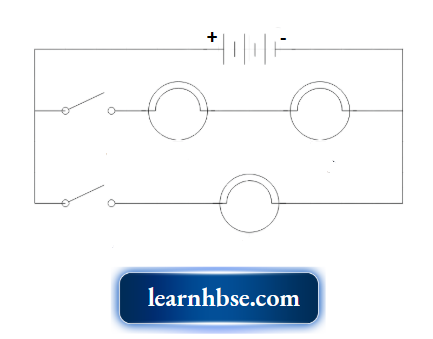
Question 10. An electric heater connected to the 240 V main supply draws a current of 10 A. Find:
- Power of the heater
- Energy consumed in 2 minutes
Answer:
P = VI P = 240 x 10 = 2400 W
Energy consumed = Vlt = 2400 x 120 = 28800 Joules
Question 11. When a 6Ω resistor is connected across the terminals of an 18 V battery, Calculate the coulomb passing through the resistor per second.
Answer:
V = IR; 18 =I x 6; I = 3A = 3C/s
Question 12. Name the black substance of pencil. Will the current flow through the electrical circuit when we use the sharpened ends of the pencil to complete the circuit?
Answer:
Graphite. Yes, current will flow through the circuit since graphite is a good conductor of electricity.
Question 13.
- Which gas is filled in an electric bulb and why?
- State Ohm’s law.
Answer:
- Argon or neon gas is filled in electric bulbs. These gases are used because they are inactive or inert. This prolongs the life of the filament,
- Ohm’s law: At a constant temperature, the current flowing through a conductor is directly proportional to the potential difference across its ends.
Question 14. The values of potential difference V applied across a resistor and the corresponding values of current I flowing in the resistor are given below:

- What is the nature of the V-l graph plotted for the above values of potential difference and current?
- Which law is illustrated by such a type of graph?
Answer:
- Straight line graph
- Ohm’s law is illustrated when the nature of V-1 graph is a straight line.
Question 15. From the following electric circuit:
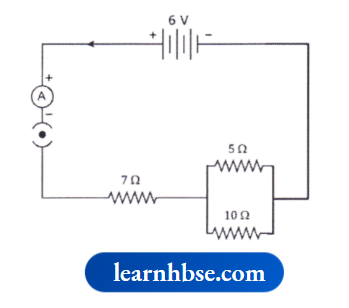
Calculate:
- Resultant resistance and current
- Heat energy evolved when the circuit is switched on for 30 minutes
Answer:
For the given circuit,
- Resultant resistance, Req = 10.33 Ω; Total current, I = V/Req = 6/ 10.33 = 0.58 A
- Heat energy evolved in this circuit if it is switched on for 30 min. By Joule’s law of heating, H = l2Rt = (0.58)2 x 10.33 x 1800 = 6255J
Question 16.
- Define power,
- What is the SI unit of power?
- What is the commercial unit of electrical energy?
Answer:
- Work done per unit time is called power,
- The SI unit of power is Watt (W).
- The commercial unit of electrical energy is kilowatt-hour (kWh)
Question 17. Three resistors of 5Ω, 10Ω, and 20Ω, respectively, are connected to a battery of 12 V as shown in the circuit given below.
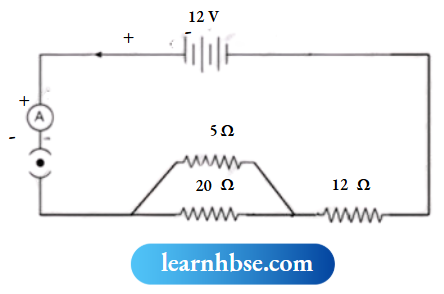
Calculate:
- Current through each resistor
- Total current in the circuit
- Total resistance of the circuit
Answer:
Effective resistance for the parallel combination of 5 Ω and 20 Ω is given by 1/R = 20+5
20×5; R=4 . Hence, total resistance in the circuit 12 + 4 = 16 Ω.
Current drawn from the battery = 16/12 = 4/3 = 1.33 A
- Potential difference across the parallel combination of resistors is (4/3) x 4 = (16/3) V. Hence, current through 5 Ω resistor is (16/15) A and current through 20 Ω resistor is (16/60) =(4/15) A.
- Total current drawn from the battery (4/3) = 1.33 A
- Total resistance in the circuit 12 + 4 = 16
Question 18. An electric appliance of 1.5 kW power rating operates on a 220V main supply and has a current rating of 5 A. Is this fuse suitable for this electrical appliance? Explain.
Answer:
Power, P = 1.5 kW = 1500 W; V = 220 V; Current drawn, P = V x I
Therefore, I = P/V = 1500/220 = 6.81 A ≈ 7 A
The current drawn by the electrical appliance is 7 A, which is beyond the fuse rating capacity in the circuit, therefore, it will melt and break the circuit.
Hence, the fuse wire of 5 A rating would not be suitable for this electrical appliance.
Question 19.
- Write the expression for the relationship between resistance and resistivity.
- A 1.25 kW electric oven is connected to a 230 V power source. Calculate
- Electric current passing through the oven
- Resistance of the oven
- Electric energy consumed in a 4-hour use of the oven
Answer:
- ρ = R x A/ I, where ρ = resistivity of material, R = Resistance of conductor, I = Length of conductor
- Power rating of the oven, P = 1.25 kW = 1250 W ; Potential difference of the power supply, V = 230 V
- Power, P = V x I; Therefore, I = P/V = 1250/230 = 5.43 A
- Resistance and power are related as P = V2/R; Therefore, R = V2/P = (230)2/1250 = 42.32 Ω
- Energy consumed by the oven is E = P x t = 1.25 kW x 4 h = 5 kWh
Question 20. If three resistors of 6 Ω, 7 Ω, and 10 Ω are connected in series. Calculate the equivalent resistance in the circuit.
- What is the potential difference across the three resistors R1, R2, and R3 in a series combination if the potential across the circuit is V?
- What is the current along each of the resistors in a series combination if the current flowing in the circuit is I?
- Is the equivalent resistance in the parallel combination of resistors more than the value of each individual resistor?
Answer:
Equivalent resistance when the resistors are connected in series is Rs = R1 + R2 + R3
Therefore, Rs = 6 + 7 + 10 = 23 ohm
The potential difference (PD) across each resistor will be different in a series combination.
Across resistor R1, PD will be V1; for R2, PD will be V2, and for R3, PD will be V3.
The current across the three resistors in a series combination will be the same, i.e., T.
No, when the resistors are connected in parallel, the equivalent resistance is less than each of the individual resistors.
Question 21. An electric heater of resistance 10 Ω and a resistance wire of 8 Ω are connected in series with a 6 V battery. Find:
- Current through the circuit
- Potential difference across the electric heater
- Potential difference across an electric wire.
Answer:
1. V = IR
6 = I x (8+10)
I = 6/18 = 1/3A
2. Velectric heater= 1/3 x 10 = 10/3 V
3. Velectric wire=1/3×8 = 8/3 V
Question 22. In the given circuit, calculate
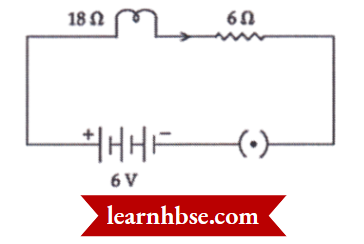
Total resistance of the circuit
Current flowing through the circuit
Potential difference across the lamp and the resistor
- Total resistance R = R1 + R2 = 18 Ω + 6Ω = 24 Ω;
- Current flowing through the circuit, I = V/R = 6/24 = 0.25 A;
- Potential difference across the lamp, V2 = IR1 = 0.25 x 18 = 4; Potential difference across the resistor R2, V2 = IR2 = 0.25 x 6 = 1.5 V
Question 23. An electrical appliance is rated 200 V, 100 W. What is the resistance of the appliance? Five such appliances run simultaneously for 4 hours. What is the energy consumed? Calculate the cost of running these appliances if the per unit cost is Rs 4.60.
Answer:
Rating of the electrical appliance is 200 V-100 W. Since P = V2/R.
Therefore, R = V2/P = (200)2/100 = 400 Ω.
Total power consumed by 5 bulbs will be 500 W.
Hence, for a four-hour operation, the energy consumed is E = P x t
E = 500×4 = 2000 Wh = 2kWh
Cost of electricity per unit is Rs 4.60. Hence, the total cost is Cost = 2 x 4.60 = Rs 9.2
Question 24.
- What is the function of an earth wire in electrical instruments? Why is it necessary to earth the metallic electric appliances?
- Explain what is short-circuiting and overloading in an electric supply.
Answer:
- The main function of earth wire is to absorb excess electricity passing through the appliance and to prevent overloading of live wire. The metallic appliances are earthed because whenever there is leakage of current, the leaked current passes thro ugh the earth wire to earth.
- Short Circuit: When live wire comes in contact with Neutral wire then the resistance becomes zero and with Ohm’s law current becomes infinite. Overloading connected sWhen a large number of home appliances are simultaneously to the same socket and they withdraw large amounts of current than mentioned on the switch.
Chapter 3 Electricity Long Questions And Answers
Question 1.
- The domestic electric supply of a house is through a 15 A fuse. Along with a 2000 W heater, how many 100 W bulbs can be used simultaneously in the house without causing overload? The domestic supply is 220 V all appliances are rated for 220 V.
- What is meant by one cycle of alternating current? and
- In a typical lightning strike, 2.5 C flows from the cloud to the ground in 0.20 milliseconds. What is the current during the strike?
Answer:
The current through the heater can be calculated as
I = P/V = 2000/ 220 = 100/11
Now the current rating through one bulb can be calculated in a similar way
i = P/V = 100/220 = 5/11
Now if there are n bulbs, then for the fuse the total current should be
15 = I + ni
15 = 100/11 + n x 5/11
15 x 11 -100 = 5n
n = 165-100/5 =13
Therefore, a total of 13 bulbs can be used simultaneously.
Question 2.
- Derive an expression for the heat produced in a conductor of resistance R when a current I flows through it for time t.
- Two identical resistors of resistance R are connected in series with a battery of potential difference V for time t. The resistors are then connected in parallel with the same battery for the same time t. Compare the heat produced in the two cases.
Answer:
A conductor offers resistance to the flow of current. Hence, work must be continuously done by the current to keep itself flowing.
When an electric charge Q moves against a potential difference V, the work done is
W = QV ….(1)
From the definition of current, Q = I x t ….(2)
From Ohm’s law, V = I x R …(3)
Therefore, W = I x t x I x R
Assuming that all this work goes in producing heat energy (H).
Therefore, the heat produced (H) in a conductor of resistance ‘R’ when current T is flowing for time ‘t’ is
H = I2Rt
2. When resistors are connected in series:
Rs + R + R = 2R
Therefore, Hs = V2/Rs = V2/2R …(1)
When resistors are connected in parallel:
∴ \(\frac{1}{R p}=\frac{1}{R}+\frac{1}{R}=\frac{2}{R}\)
Therefore, Rp = R/2
Hs = V2/ Rs = 2V2/R ….(2)
From (1) and (2)
∴ \(\frac{\mathrm{Hs}}{\mathrm{Hp}}=\frac{1}{4}\)
Therefore, Hp = 4Hs
Question 3. Derive the expression for equivalent resistance if three resistors R1, R2 and R3 are connected in a parallel combination.
Answer:
Derivation for equivalent resistance if three resistors are connected in parallel:
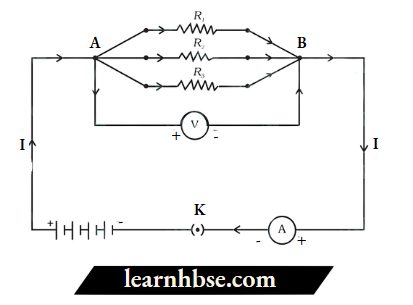
Potential difference in a parallel circuit remains the same across all resistors.
Current is the sum of the currents across all the individual resistors.
I = l1 + I2 + I3 ….(1)
Let Rp be the resultant resistance of the circuit. On applying Ohm’s law to the entire circuit,
l = V/Rp ….(2)
Now applying Ohm’s law to individual resistances,
⇒ \(\left.\begin{array}{l}
\mathrm{I}_1=\mathrm{V} / \mathrm{R}_1 \\
\mathrm{I}_2=\mathrm{V} / \mathrm{R}_2 \\
\mathrm{I}_3=\mathrm{V} / \mathrm{R}_3
\end{array}\right]…..(3)\)
From equations (1), (2) and (3),
V/ Rp = V/R1 + V/R2 +V/R3
Cancelling “V” on both sides, we get
1/ Rp =1/R1 + 1/R2 + 1/R3
Question 4. A circuit has a fuse of 5 A. What is the maximum number of 110 W (220 V) bulbs that can be safely used in the circuit?
Answer:
Suppose ‘n’ bulbs can be used safely.
Power of ‘n’ bulbs, P = 110 x n Watt
Potential difference, V = 220 V; Current, I = 5 A
Power, P = V x I
110 xn =220 x 5/110
Thus, the maximum number of bulbs that can be connected safely in the circuit is 10.
Question 5.
- List the factors on which the resistance of a conductor depends.
- A 4-kW heater is connected to a 220-V power source. Calculate
- Electric current passing through the heater
- Resistance of the heater
- Electric energy consumed in a 2-hour use of the heater
Answer:
- Power, P = VI
Therefore, I = P/V = 4000/220 = 18.18 A - P = V2/R
Therefore, R = V2/P = (220)2/4000 = 12.1 Ω - E = P x t = 4 kW x 2 h = 8kWh
Question 6. What is meant by the statement ‘the potential difference between two points is 1 V? Study the circuit shown in which three identical bulbs B1, B2, and B3 are connected in parallel with a battery of 4.5 V.
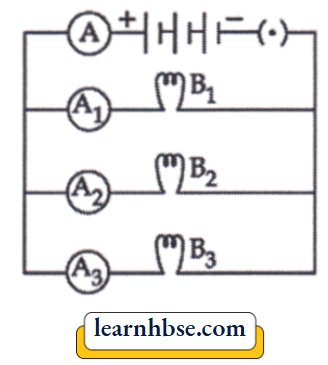
- What will happen to the glow of the other two bulbs if bulb B3 gets fused?
- If the wattage of each bulb is 1.5 W, what readings will the ammeter A show when all the three bulbs glow simultaneously?
- Find the total resistance of the circuit.
Answer:
Potential difference of 1 volt means that one joule of work is done to move a charge of one coulomb from one point to another.
- If bulb B3 gets fused, then the other two bulbs will continue glowing with the same brightness.
- When the bulbs are in parallel, wattage will be added (4.5 W) and the ammeter reading would be 45/45 = 1.0 ampere.
- Since the ammeter reading is 1.0 ampere, the resistance of the combination = 4.5V/1.0A = 4.5 Ω
Question 7. In the given circuit, A, B, C and D are four lamps connected with a battery of 60V. Analyse the circuit to answer the following questions.

- What kind of combination are the lamps arranged in (series or parallel)?
- Explain with reference to your above answer, what are the advantages (any two) of this combination of lamps?
- Explain with proper calculations which lamp glows the brightest?
- Find out the total resistance of the circuit.
Answer:
1. The lamps are connected in parallel.
2. Advantages of parallel combination: If one lamp stops working, it will not affect the working of the other lamps. – Potential difference across each lamp will be same.
3. The lamp with the highest power will glow the brightest.
P=VI
Even if the potential difference across all the lamps are same, lamp C has the highest current.
Hence, for Lamp C, P=5 x 60 Watt = 300 W.
Thus, lamp C glows the brightest.
4. Total current, I = 3+4+5+3 A = 15A
Voltage = 60 V
Since V = IR,
Hence R = V/I = 60/15 A = 4 A.
